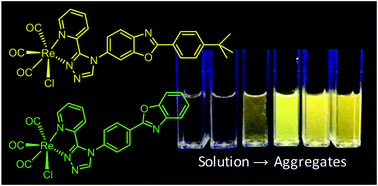Optimization of aggregation-induced phosphorescence enhancement in mononuclear tricarbonyl rhenium(i) complexes: the influence of steric hindrance and isomerism†
Abstract
In order to improve the remarkable performance of a mononuclear tricarbonyl rhenium(I) complex (ReL1) that exhibits rare aggregation-induced phosphorescence enhancement (AIPE) behavior, two new complexes (ReL3 and ReL4) were prepared and investigated. They incorporate a 2-pyridyl-1,2,4-triazole (pyta) ligand connected to a 2-phenylbenzoxazole (PBO) moiety. Complex ReL3 differs from ReL1 by the presence of a bulky tert-butyl substituent, and ReL4 is an isomer where the PBO group is linked to the pyta ligand by its phenyl group. Theoretical calculations were in congruence with electrochemical and spectroscopic properties in solutions. Both new compounds exhibited strong AIPE and much better solid-state emission efficiency than ReL1, with photoluminescence quantum yields up to 55% for ReL4. Crystallographic data indicate that this increase in emission efficiency is due to optimum packing that prevents quenching. This work shows that minor structural changes may have major effects upon the solid-state spectroscopic properties and it provides a rational basis for accessing AIPE-active strongly emissive rhenium(I) complexes.

- This article is part of the themed collection: Spotlight Collection: Aggregation induced luminescence of metal complexes


 Please wait while we load your content...
Please wait while we load your content...